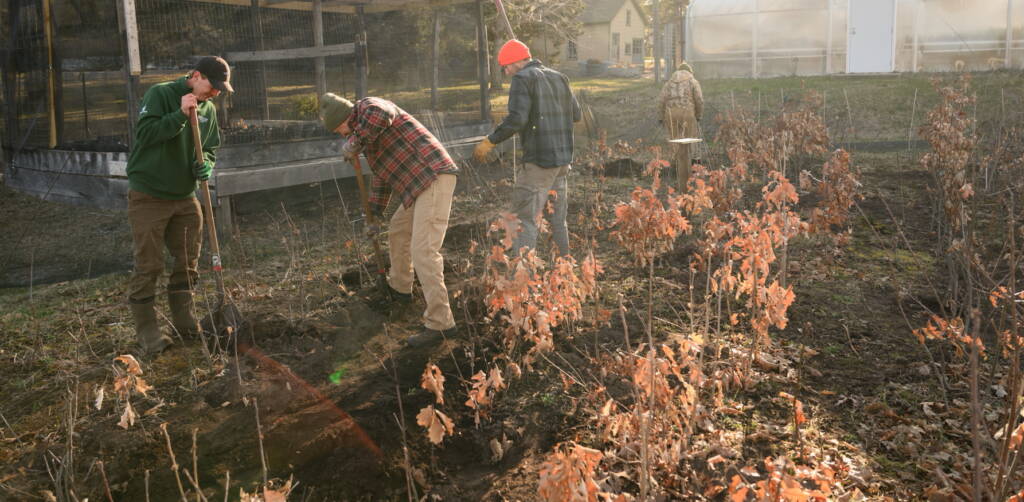The beauty of the natural surroundings is a big part of the College of Saint Benedict and Saint John’s University experience.
A pair of initiatives now underway in the Saint John’s Abbey Arboretum and across the two campuses aim to ensure that the environmental features that make these places so special continue to thrive in the years to come.
“The beauty of these places has a way of shaping you,” CSB and SJU President Brian Bruess said. “It invites you to slow down, to pay attention and to care.
“These projects are about living out our Benedictine values of stewardship, community and deep connection to the land. It’s about making sure future generations of Bennies and Johnnies get to fall in love with these places the same way we have. It’s inspiring to see our community thinking long-term, working together and planting the kind of hope that will grow for decades to come.”
The first initiative is a tree planning project that began two years ago with the creation of the Abbey Forest Nursery, located near the grounds department on the SJU campus.
There, acorns collected from existing trees in the arboretum have been planted, creating new oaks. Oaks were chosen because they support more biodiversity than any other tree in Minnesota. Around 3,000 trees are currently growing – the first 1,000 of which are now being replanted across a five-acre spread of land south of the old SJU campus entrance road.
“Father Paul Schweitz, OSB (the founder of the arboretum, who passed away in 2000) was the first person to envision this initiative,” said John Geissler, director of Outdoor U at CSB and SJU and the Abbey Land Manager. “He knew that all of our land was logged off pretty extensively in the early days of the abbey and university when the Quad was heated with firewood. That meant all those trees came back at the same time as well.
“When you’re looking at forest resilience against climate change, you want not just biodiversity, but age diversity as well. We have biodiversity with a lot of different species of trees. But our age diversity is a C-minus at best because so many of our trees are the same age.”
The plan is to continue replanting another five-acre spread each year, a task that will require 125 years to create the ultimate mosaic of age diversity through the oak-dominated parts of the arboretum.
“This definitely is a long-range plan,” Geissler said. “But it’s really cool to be working at a place that looks out that far.”
Members of the arboretum staff, a corps of around 10 to 12 volunteers and participants in various service-learning projects from on and off campus, have been helping with the planting. The trees are best replanted when they are around waist high, which is why it’s taken two years for the first group to be ready.
“You want them to get above the competition in the woods and also above deer height as fast as possible,” Geissler said. “We’ve actually been piloting this program for about six years. We were fortunate to have the help and advice of retired nursery owner Larry Huls as we piloted this program which develops really strong root structure and height. These trees handle transplanting well (which gives them) the best chance to be successful.”

The other initiative underway is the creation of a series of pollinator gardens on the two campuses. Over the past three years, Geissler said over 80,000 square feet of campus turf has been converted to such gardens, which are made up of native plants designed to attract and support pollinators like bees, butterflies and other insects. The majority of that space has been on the SJU campus, but locations for pollinator gardens are being identified at CSB as well.
“We’ve been looking for spots on campus with turf grass that hasn’t been used for anything, but has still needed to be maintained,” Geissler said. “We’ve collected seeds from our prairie land to grow plants in our green house, then taken the sod out of those spots and replaced it with the new plants.”
CSB and SJU Physical Plant director Russ Klein said such gardens have benefits well beyond their impact on the environment.
“It reduces labor and cost,” he said. “We’re buying less fuel for lawnmowers because we have less space to mow. We don’t need to sharpen the blades. We don’t need to water. These plants are native to this area and hardy enough to survive on their own when they’re established. They are homegrown plants and they do a lot when it comes to campus beautification. Once these gardens are established, they look amazing.”
Klein said the gardens also meet the definition of xeriscaping – a process of landscaping or gardening that reduces or eliminates irrigation needs.
“We treat water as a precious resource here,” he said. “We know there is a finite amount. And when you don’t need to water as much space, it helps a lot with conservation.”
Geissler echoed those sentiments.
“The beauty of these is that there is no cost for mowing, watering or fertilizing them,” he said. “Nature takes care of everything. It helps the insects and improves water quality, which in turn improves the habitat.
“But it also helps the grounds crew. A lot of times, we’re putting them on slopes they didn’t like to mow anyway. Those spaces tend to have the highest erosion rates. So putting something like this in just makes sense.”
